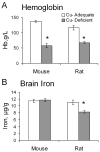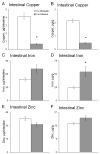Copper deficient rats and mice both develop anemia but only rats have lower plasma and brain iron levels
- PMID: 18178529
- PMCID: PMC2295218
- DOI: 10.1016/j.cbpc.2007.11.008
Copper deficient rats and mice both develop anemia but only rats have lower plasma and brain iron levels
Abstract
Iron homeostasis depends on adequate dietary copper but the mechanisms are unknown. Mice (Mus musculus) and rat (Rattus norvegicus) offspring were compared to determine the effect of dietary copper deficiency (Cu-) on iron status of plasma, liver, brain and intestine. Holtzman rat and Hsd:ICR (CD-1) outbred albino mouse dams were fed a Cu- diet and drank deionized water or Cu supplemented water. Offspring were sampled at time points between postnatal ages 13 and 32. Cu- rat and mouse pups were both anemic, but only rat pups had lower plasma and brain iron levels. Plasma iron was lower throughout the suckling period in Cu- rats but not Cu- mice. Cu- mice derived from dams restricted of Cu only during lactation were also severely anemic without hypoferremia. Intestinal metal analysis confirmed that Cu- pups had major reductions in intestinal concentration of Cu, increased Fe, and normal Zn. However, whole mouse (less the intestine) analysis demonstrated normal content of Fe indicating that the limitation in iron transport by intestinal hephaestin had no consequence to total iron reserves of the mouse. Further research will be needed to determine the reason Cu- mice were anemic since the "ferroxidase" hypothesis does not explain this phenotype.
Figures





Similar articles
-
Rodent brain and heart catecholamine levels are altered by different models of copper deficiency.Comp Biochem Physiol C Toxicol Pharmacol. 2007 Mar;145(2):275-81. doi: 10.1016/j.cbpc.2006.12.013. Epub 2007 Jan 12. Comp Biochem Physiol C Toxicol Pharmacol. 2007. PMID: 17287146 Free PMC article.
-
Multiple mechanisms account for lower plasma iron in young copper deficient rats.Biometals. 2008 Jun;21(3):343-52. doi: 10.1007/s10534-007-9123-6. Epub 2007 Nov 24. Biometals. 2008. PMID: 18038202 Free PMC article.
-
Maternal iron and zinc supplementation during pregnancy affects body weight and iron status in rat pups at weaning.J Nutr. 2011 May;141(5):798-804. doi: 10.3945/jn.110.135681. Epub 2011 Mar 23. J Nutr. 2011. PMID: 21430246
-
Iron imports. III. Transfer of iron from the mucosa into circulation.Am J Physiol Gastrointest Liver Physiol. 2006 Jan;290(1):G1-6. doi: 10.1152/ajpgi.00415.2005. Am J Physiol Gastrointest Liver Physiol. 2006. PMID: 16354771 Free PMC article. Review.
-
The ceruloplasmin homolog hephaestin and the control of intestinal iron absorption.Blood Cells Mol Dis. 2002 Nov-Dec;29(3):367-75. doi: 10.1006/bcmd.2002.0576. Blood Cells Mol Dis. 2002. PMID: 12547227 Review.
Cited by
-
The mammalian phosphate carrier SLC25A3 is a mitochondrial copper transporter required for cytochrome c oxidase biogenesis.J Biol Chem. 2018 Feb 9;293(6):1887-1896. doi: 10.1074/jbc.RA117.000265. Epub 2017 Dec 13. J Biol Chem. 2018. PMID: 29237729 Free PMC article.
-
Associations of serum concentrations of metal nutrients with postpartum anemia among pregnant Chinese women: A large retrospective cohort study.Front Nutr. 2023 Apr 17;10:1086082. doi: 10.3389/fnut.2023.1086082. eCollection 2023. Front Nutr. 2023. PMID: 37139457 Free PMC article.
-
Whole-genome sequencing identifies a novel ABCB7 gene mutation for X-linked congenital cerebellar ataxia in a large family of Mongolian ancestry.Eur J Hum Genet. 2016 Apr;24(4):550-5. doi: 10.1038/ejhg.2015.139. Epub 2015 Aug 5. Eur J Hum Genet. 2016. PMID: 26242992 Free PMC article.
-
Impact of copper limitation on expression and function of multicopper oxidases (ferroxidases).Adv Nutr. 2011 Mar;2(2):89-95. doi: 10.3945/an.110.000208. Epub 2011 Mar 10. Adv Nutr. 2011. PMID: 22332037 Free PMC article. Review.
-
Leishmania major-induced alteration of host cellular and systemic copper homeostasis drives the fate of infection.Commun Biol. 2024 Sep 30;7(1):1226. doi: 10.1038/s42003-024-06716-2. Commun Biol. 2024. PMID: 39349621 Free PMC article.
References
-
- Andersen HS, Gambling L, Holtrop G, McArdle HJ. Effect of dietary copper deficiency on iron metabolism in the pregnant rat. Br J Nutr. 2007;97:239–246. - PubMed
-
- Andrews NC, Schmidt PJ. Iron homeostasis. Annu Rev Physiol. 2007;69:69–85. - PubMed
-
- Brubaker C, Sturgeon P. Copper deficiency in infants; a syndrome characterized by hypocupremia, iron deficiency anemia, and hypoproteinemia. AMA J Dis Child. 1956;92:254–265. - PubMed
-
- Chen H, Huang G, Su T, Gao H, Attieh ZK, McKie AT, Anderson GJ, Vulpe CD. Decreased hephaestin activity in the intestine of copper-deficient mice causes systemic iron deficiency. J Nutr. 2006;136:1236–1241. - PubMed
-
- Chen H, Su T, Attieh ZK, Fox TC, McKie AT, Anderson GJ, Vulpe CD. Systemic regulation of Hephaestin and Ireg1 revealed in studies of genetic and nutritional iron deficiency. Blood. 2003;102:1893–1899. - PubMed
Publication types
MeSH terms
Substances
Grants and funding
LinkOut - more resources
Full Text Sources
Medical

